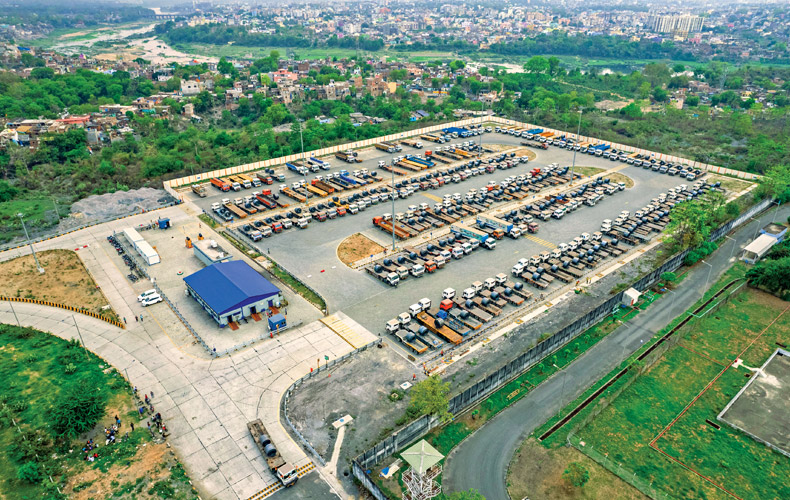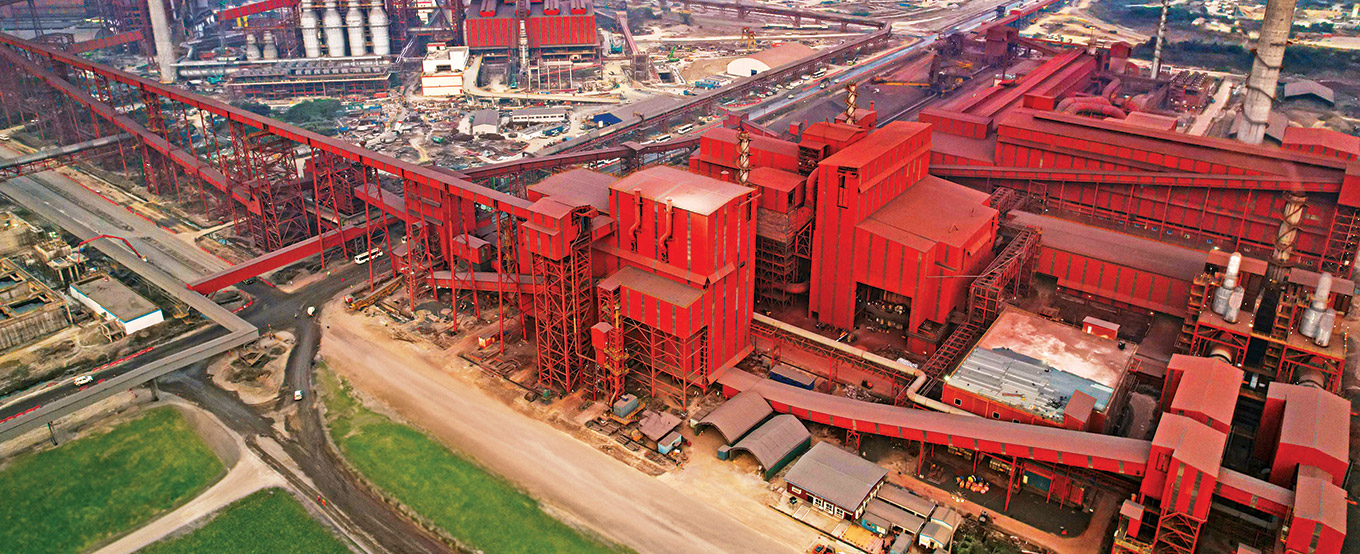Manufactured Capital
Tata Steel's advanced production facilities, robust infrastructure, and mining assets ensure high-quality steel products, operational efficiency, and sustainable growth to meet global market demands and drive innovation.
35 MTPA
Consolidated steelmaking capacity
Tata Steel is one of the most diversified integrated steel producers in the world, with an annual crude steel production capacity of 35 MTPA across manufacturing assets in India, the Netherlands, the UK, and Thailand. In India, the Company has operations in Jamshedpur and Gamharia in Jharkhand, and in Kalinganagar and Meramandali in Odisha, with an overall capacity of 21.6 MTPA. The acquisition of Neelachal Ispat Nigam Limited, with an overall crude steel production capacity of 1 MTPA in the long products segment, has helped the Company to balance its product portfolio and will play a critical role in the Company’s long products growth aspiration. The Company also works with different steel processing centres to convert semi-finished steel products into finished goods.
The Company is also expanding its downstream units in tandem with the upstream.
JAMSHEDPUR, INDIA
11 MTPA
The flagship Jamshedpur plant is amongst the first steel plants in Asia and the only facility in India to produce steel at the same site continuously for over 100 years. The Company’s sustainable growth has been driven by its operational excellence and a culture of continuous improvement.
MERAMANDALI, INDIA
5.6 MTPA
The Meramandali plant in Odisha is one of India’s largest flat steel production plants, equipped with steelmaking and finishing facilities.
KALINGANAGAR, INDIA
3 MTPA
Commissioned in 2016, the Kalinganagar plant attained production levels at its rated capacity of 3 MTPA in less than two years. A capacity expansion to 8 MTPA (Phase II) is currently underway, which will augment the Company’s product portfolio with new value-added products while driving operational efficiency and reducing carbon footprint.
1 MTPA
The Neelachal Ispat Nigam Limited unit is an integrated steel plant at Kalinganagar, Odisha, which produces 1 MTPA of long products, through the blast furnace route.
GAMHARIA, INDIA
1 MTPA
The Gamharia plant specialises in the production of high-alloy, value-added steel for diverse applications. It is one of the largest manufacturers in India in the Special Bar Quality (SBQ) steel segment with 1 MTPA capacity. It also boasts a 1 MTPA facility for sponge iron and 160 MW power generation.
IJMUIDEN, THE NETHERLANDS
7 MTPA
The IJmuiden steelworks site operates two blast furnaces with a steelmaking capacity of 7 MTPA, one of the largest in Europe. The high-quality flat steel products are supplied to markets around the world, including construction, automotive, packaging, and the manufacturing of lifting, mining, and earthmoving equipment.
PORT TALBOT, THE UNITED KINGDOM
5 MTPA
The integrated iron and steel works at Port Talbot currently operates two blast furnaces, with a production capacity of 5 MTPA of liquid iron. Being the largest steel producer in the UK, Tata Steel produces high quality differentiated strip steel products for the construction, automotive, packaging and engineering markets.
SARABURI, RAYONG AND CHONBURI, THAILAND
1.7 MTPA
Tata Steel (Thailand) Public Company Limited (TSTH) is one of the largest and most diverse long steel manufacturers in Thailand, using recyclable steel scrap as raw material. With 3 manufacturing plants located in the provinces of Saraburi, Rayong, and Chonburi, the Thailand facilities specialise in manufacturing bars, rebars, wire rods and small sections.
Expansion projects - India
The Kalinganagar Phase II expansion is in progress. Please refer to the section 'The growth of Kalinganagar' on the next page.
The Company is also expanding its downstream units in tandem with the upstream. Having acquired and integrated the tube mills of erstwhile Bhushan Steel Limited, the Company now produces more than 1 MT of tubes annually, making it the second largest tubes manufacturer in India.
The Company is also investing in the capacity expansion of its tinplate plant. Significant investments are also being made towards the special bar and wire rod combi mills of The Indian Steel and Wire Products Limited, which is currently in the process of getting amalgamated into and with Tata Steel Limited.
Making steel manufacturing process green
Along with capacity expansion, Tata Steel remains focused on improving the sustainability performance of its assets. In April 2023, in Jamshedpur, the Company executed a hydrogen injection trial using 40% of the injection systems in the E Blast Furnace. It was the first time in the world that such a large quantity of hydrogen was continuously injected into a blast furnace.
Global operations
Tata Steel’s total crude steel production capacity stands at 12 MTPA between operations in the Netherlands and the United Kingdom (UK). The downstream operations span across Belgium, France, Germany, the United States, Sweden, Spain and other countries. The Company is transitioning towards low-CO₂ steelmaking in the UK and the Netherlands. The Company is also in discussion with the Dutch government about closing one of the two blast furnaces in the Netherlands by 2030 and replacing it with a Direct Reduced Iron (DRI) - electric arc furnace (EAF). Meanwhile, the Company is also making interventions to reduce emissions and improve the efficiency of the existing assets.
The Company has reached an agreement with the UK Government on proposals to replace the end-of-life upstream assets with an EAF, reducing direct CO2 emissions by 50 MT over a decade.
With three green steel production facilities located in the central and eastern regions of Thailand, the Company supplies long products including rebars and wire rods across South Asia.
Amongst the three plants, Tata Steel has an annual capacity of 1.7 MT of crude steel in Thailand. The Company intends to use more scrap in its manufacturing process.

Transport Park, Tata Steel Jamshedpur
Setting new benchmarks in sustainable supply chain
Supply chain and logistics
Supply chain and logistics are integral parts of the steel value chain. The Company is responsible for planning, sourcing, delivery and logistics of more than 100 MT of raw material, finished goods and byproducts across its Indian footprint. Annually, more than 60 MT of raw material, comprising 200+ grades from 54 global sources is planned, scheduled and transported to 40+ internal consumption centres in India. On the delivery side, 20 MT of finished goods, consisting of around 20,000 stock keeping units (SKUs) from approximately 65 production units (including Steel Processing Centres) are delivered to diverse customers. All its material movement is enabled through 7 ports, 25 stockyards and 36 Steel Processing Centres.
As the Company plans to double its capacity in India, the scale and complexity of supply chain and logistics will increase. The Company strives to create a future-ready supply chain through digitalisation, building top-notch infrastructure and inculcating sustainable practices. Of the 21 MT of raw materials imported through the ports on India’s eastern coast, around 5 MT were handled through the recently opened Kalinga International Coal Terminal at the Paradip Port in FY2023-24. Other major infrastructure development projects are underway to support the growth plan. These include the construction of a slurry pipeline, alternative port capacity, and improvements to the rail networks and tracks.
The Company has revamped the finished goods value chain under the Integrated Supply Chain Management programme for flat products with the adoption of production planning and transportation management systems to provide customers with a first-of-its-kind approach in the Indian steel industry. It has established new IT solutions such as Rail Turnaround Time Optimisation in the raw material value chain to decrease operational waste and increase asset utilisation using analytics and machine learning algorithms.
Tata Steel established a live Sustainability Data Ecosystem Dashboard for shipping-related emission calculation, reporting, and analytics in partnership with IHS Markit (now merged into S&P Global). Focussing on the three key components of optimum cost, judicious infrastructure spending and reliable operations, the supply chain is prepared to meet future demands.

The growth
of Kalinganagar
After successful commissioning and ramp up of the Phase I of the Kalinganagar plant, Tata Steel commenced the Phase II expansion from 3 MTPA to 8 MTPA in 2018. The expansion is in progress and is a step towards achieving the goal of 35 MTPA - 40 MTPA in India by 2030.
The 4.3 MTPA Blast Furnace 2 is the largest greenfield blast furnace in the world and equipped with the best features for a long campaign life and eco-friendly design. The second blast furnace will help take the overall production capacity of hot metal in Kalinganagar to 8 MTPA.
The 6.4 MTPA Pellet Plant has been commissioned and successfully ramped up. It is the first in India to adopt bag houses for process dedusting of Induration Furnace in place of Electro Static Precipitators to reduce dust emissions < 10 mg/Nm3 as against the norms of 30 mg/Nm3 . It is designed to produce high basicity pellets to meet blast furnace burden requirements and will ensure adequate pellet supply to Kalinganagar and Meramandali.
The Cold Roll Mill at the Kalinganagar plant is designed with state-of-the-art facilities. It is the widest and strongest mill in India capable of doing up to 1,180 MPa advance high-strength steel with Solid State Automatic Laser Welder and Automatic Storage & Retrieval system for product coils storage vertically. The facility includes one 2.2 MTPA Coupled Pickling & Tandem Cold Mill, one 0.9 MTPA Continuous Annealing line and two Continuous Galvanising lines of 1 MTPA. The Pickling Line Tandem Cold Mill commissioned during the year has augmented the product portfolio of Tata Steel through the production of high-strength cold rolled coils to meet the requirements of the automotive customers.